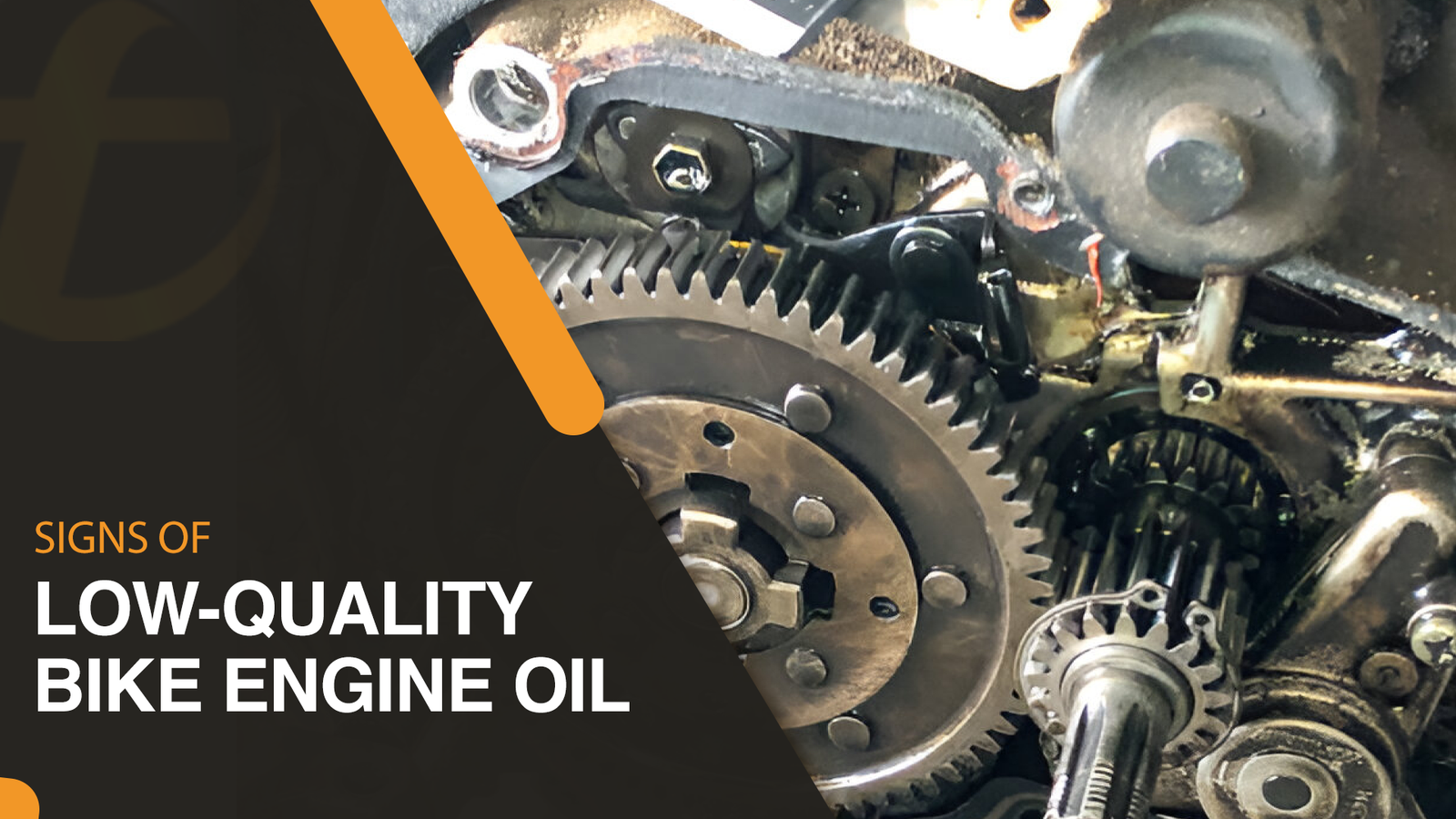
Motorcycle enthusiasts understand the exhilaration of riding the open road, feeling the wind, and mastering every curve. However, amidst this excitement, it’s vital to prioritize proper maintenance, especially for the engine—the bike’s heart.
Central to engine care is choosing the right motorcycle oil. The ideal oil keeps your bike running smoothly and ensures you won’t be stranded.
High-quality oil isn’t just a luxury for motorcycle engines; it’s essential. It acts as the lifeblood of your bike, ensuring its engine runs smoothly and efficiently.
Engine oil is vital for every motorcycle engine. However, various circumstances can cause issues. This guide will explore common motorcycle oil problems and solutions to address them effectively.
Contamination or Degradation in Low-Quality Oil
Contaminants like dirt, water, and air play a significant role in speeding up lubricant degradation. Dirt, especially with fine metal particles, can accelerate this process. Air and water introduce oxygen, which reacts with the oil, causing it to oxidize. Regular oil analysis can assist in tracking contamination levels in your lubricant.
Possible Causes of Odors in Low-Quality Oil
Your car communicates with you surprisingly, one of which is through unusual smells. These odors can signal potential issues under the hood, so paying attention early on can help you catch problems before they escalate.
If you smell something burning, your engine is overheating, or your brakes aren’t working right.
Check your temperature gauge first to see if your engine is too hot. Then, look for leaks or damage in your coolant reservoir and radiator. If you’re low on coolant, fill it up and fix any problems you see in your cooling system.
If you smell something burning and your brakes aren’t working right, check them out. Replace or fix any damaged parts.
If you can’t figure out where the smell is coming from or are still having trouble after fixing things you can see, get a mechanic to check it out.
If you smell gas or diesel outside your car, it might mean a dangerous fuel leak. Look around for leaks, check the fuel lines, and ensure the fuel cap is closed tightly. Don’t drive until you’ve fixed the leak.
How Low-Quality Oil Can Affect Engine Performance
The engine ensures smooth movement of every part of your vehicle, reducing friction and wear. Quality oil maintains consistent viscosity, providing optimal lubrication in various temperatures, from cold starts to high-temperature conditions.
Its main job is to reduce friction between moving parts, preventing excessive wear. Low-quality oil lacking proper lubricating properties can increase friction, leading to quick wear and potential engine failure.
Furthermore, high-quality oil helps dissipate the heat generated during combustion, thereby preventing engine overheating. This effective heat dispersion ensures consistent engine performance and mitigates the risk of component deformation due to excessive temperatures.
Engine oil keeps the engine clean by removing dirt, debris, and residue and putting them in the oil filter. However, as oil ages, it doesn’t clean well and can cause buildup that might affect your engine’s work.
Choosing the right oil for your car, one that meets the manufacturer’s specifications, can make your vehicle more fuel-efficient, reduce emissions, and extend the life of your engine. Regular oil changes with high-quality oil keep your engine’s important parts safe and working well.
Signs Indicating the Need for an Oil Change
Regular oil changes are a key part of your vehicle’s upkeep. They might seem simple, but they’re vital for running your car smoothly. Skipping them can cause problems like lower fuel efficiency, serious engine damage, or even failure.
When should you change your oil? The top signs indicate when it’s time for an oil change or related maintenance work.
Knocking or Engine Noise
Engine oil’s main job is to lubricate. When there’s not enough oil, the moving parts in the engine don’t get the lubrication they need. This can cause a light tapping or knocking sound from metal-to-metal contact.
If the oil pressure is low, you might hear noise from the lifters or cam bearings. Engine noise can also occur if the oil is old and has lost its ability to lubricate properly.
If you hear engine noise, immediately check your oil level and condition and change it if needed. This noise is a clear sign you need an oil change. You might also need to add oil to make it safe to drive to the mechanic.
Exhaust Emissions
Usually, your car’s exhaust is mostly invisible, though it might have a slight smell. Gasoline engines produce very little visible exhaust, unlike diesel engines, which can emit black, sooty smoke.
You might see a cloud from your tailpipe in cold weather, but water vapor disappears as the engine warms up. However, if you see bluish smoke from your exhaust, there’s a problem.
Blue smoke usually means oil gets into the engine and burns with the fuel, indicating low oil levels. There might also be an external oil leak dripping onto the exhaust system. If the exhaust is grayish, it’s likely due to the engine burning too much fuel.
Overheating
Low oil levels do not typically cause overheating, but you should consider it. It’s usually noticed when your coolant is low, but insufficient oil can also lead to engine overheating.
Even if your coolant level is adequate, a lack of oil can prevent proper engine cooling. The temperature gauge goes up when the engine coolant can’t remove enough heat. Remember, the indicator shows coolant temperature, not oil temperature.
If your coolant gauge shows unsafe levels (yellow or red), pull over safely and let the engine cool down. Check the oil level while it cools; if it’s low, add more before driving to a mechanic. Wait until the engine is completely cool before checking the coolant level to avoid burns from the hot coolant.
Importance of Regularly Analyzing Oil for Detecting Oil Quality
Maintenance professionals can extend the life of their equipment and lubricants by starting an ongoing oil analysis program. This program finds contamination early, reduces surprise maintenance, lengthens the time between oil changes, and helps with warranty claims.
An oil analysis involves running tests to check the condition of equipment and the lubricants used. It gives a detailed report on how well the lubrication system is working. This helps maintenance teams spot any potential equipment failures, determine how long the lubricant will last, and detect any contamination in the lubricant.
Knowing that you can’t get accurate results from just one oil sample is important. Taking multiple samples to see trends, such as trend monitoring or analysis, would be best. For example, technicians typically perform an oil analysis on a compressor every 2,000 hours or every six months. The more data you have, the better your understanding will be.
Regular oil analysis can identify the specific contaminant if a lubricant becomes contaminated. Various forms of pollution can impact machinery in diverse manners. For instance, air and water can disrupt the fluid film required for surface detachment.
Identifying these issues early allows maintenance professionals to address them before they escalate, reducing repairs and minimizing downtime.
If the oil in your machinery gets contaminated, regular checks can tell us what’s causing the problem. Different types of dirt can mess up the way machines work.
For instance, air and water can mess with oil’s ability to keep things running smoothly. By catching these issues early, we can fix them before they become big headaches, saving time and money on repairs.
At Fubex, our trained Quality Assurance team checks the results once all tests are done.
These days, we’re using more online sensors, which give us the benefits of lab analysis and sensors. In addition to our regular testing, Fubex can also help with any special technical problems.
When your equipment works well for a longer time, it is more efficient and requires fewer expensive replacement parts. This saves you time and money.
Regular oil analysis helps by:
- Save money by predicting and preventing damage.
- Improve equipment reliability.
- Reduce downtime and increase productivity.
- Minimize unexpected maintenance and repairs.
Bottom Line
Regular oil analysis is key to keeping your equipment in top shape and extending its lifespan. By checking oil quality regularly, you can predict and prevent damage, improve reliability, reduce downtime, and minimize unexpected repair costs. This proactive approach saves you time and money, ensuring your machinery’s smooth and efficient operation.
For over 15 years, Fubex Lubricants has been a trusted name in engine lubricants. We continually improve and innovate our motorcycle oils to meet the industry’s highest standards. Our oils are crafted to offer top-notch protection in all riding conditions, whether hot or cold, ensuring smooth starts and compatibility with wet clutches.
FAQS
Q1: Can low-quality engine oil cause damage to my motorcycle’s engine?
Ans: Bad engine oil can reduce fuel efficiency, weaken lubrication, and cause more blow-by from oil leaks.
Q2: How can I tell if oil is bad?
Ans: You can begin by assessing the oil using your senses: taste, smell, and appearance. Poor-quality oil often has a sharp taste and may emit an unpleasant odor.
Q3: Are there any additives I can use to improve the quality of my motorcycle engine oil?
Ans: Yes, oil additives can enhance oil performance between changes and provide long-term protection for your engine.


